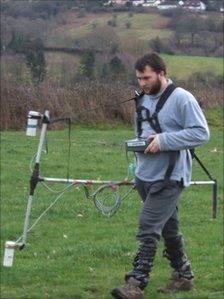Major buildings find at Roman fortress of Caerleon
- Published
Archaeologists have discovered several large buildings at the fortress of Caerleon in south Wales, one of Britain's best known Roman sites.
The major discovery was made by chance by students learning to use geophysical equipment.
Cardiff University's Peter Guest said the find was "totally unexpected" .
It is possible the buildings, which may include baths and temples, are first evidence of Roman plans to develop Caerleon into a major settlement.
Caerleon (Isca), which dates from AD 75, is one of three permanent legionary fortresses in the UK, and was used for 200 years. The others at Chester and York - are mostly buried and difficult to excavate.
"It is difficult to be certain about what we have found because nothing like this has been discovered in Roman Britain before," he said of the latest discovery.
The students were using the geophysical equipment in fields outside the Roman fortress - an area that was not thought to have been extensively occupied in the Roman period.
Ten days later the students and their tutors found the outlines of a series of huge buildings squeezed into the ground between the amphitheatre and the River Usk.
Dr Guest, a senior lecturer in Roman archaeology, said: "Caerleon is one of the best known Roman sites in Britain, so it was a great surprise to realise that we had found something completely new and totally unexpected.
He said the buildings' ground plans suggest that they were of some importance.
"We think they could have included markets, administrative buildings like town halls, bath houses, store buildings, or even possibly temples.

Final excavations are going on at the fortress site
"The biggest is enormous and must be one of the largest buildings known from Roman Britain."
Dr Guest said: "We can only guess what it was for, but at the moment we're working on the idea that it had something to do with a harbour on the river, although it does look uncannily like a residential villa building - if that's the case it was built on a palatial scale."
The layout and scale of the buildings look like they should be at the centre of a town or city, the archaeologist added.
"But here at Caerleon we seem to have the central public spaces without the surrounding city - where are the people who would have used these buildings?."
"That's the great thing about an archaeological discovery like this - lots of questions that we just don't have definite answers to at the moment."
Guided tours
The latest discovery was made as part of ongoing excavations by the university.
Over the last four years, eight previously unknown barrack blocks have been found at Caerleon, along with three large granaries, a monumental metal workshop and a very large store building.
Final excavations are taking place for the next six weeks inside the Roman fortress involving staff and students from University College London (UCL) and it is hoped more discoveries will be made.
The dig is open to the public and there will be guided tours of the excavation site.
The Roman museum there dates back 150 years.
- Published9 August 2010